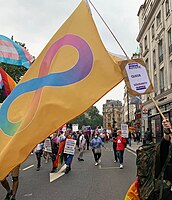
Autism
Autism, also called autism spectrum disorder[a] (ASD) or autism spectrum condition (ASC),[10] is a neurodevelopmental disorder marked by deficits in reciprocal social communication, and the presence of restricted and repetitive patterns of behavior. Other common signs include difficulty with social interaction, verbal and nonverbal communication, along with perseverative interests, stereotypic body movements, rigid routines, and hyper- or hyporeactivity to sensory input. Autism is clinically regarded as a spectrum disorder, meaning that it can manifest very differently in each person. For example, some are nonspeaking, while others have proficient spoken language. Because of this, there is wide variation in the support needs of people across the autism spectrum.
Autism
- Autism spectrum disorder (ASD),[a] autism spectrum condition (ASC)
- Formerly: Kanner syndrome/autistic disorder/childhood autism, Asperger syndrome (AS), childhood disintegrative disorder (CDD), pervasive developmental disorder not otherwise specified (PDD-NOS)
Difficulties in social interaction, verbal and nonverbal communication, and the presence of repetitive behavior or restricted interests
Social isolation, educational and employment problems,[1] anxiety,[1] stress,[1] bullying, depression,[1][2] self-harm, suicidality[3][4]
Early childhood
Lifelong
Multifactorial, with many uncertain factors
Family history, certain genetic conditions, having older parents, certain prescribed drugs, perinatal and neonatal health issues
Based on combination of clinical observation of behavior and development and comprehensive diagnostic testing completed by a team of qualified professionals (including psychiatrists, clinical psychologists, neuropsychologists, pediatricians, and speech-language pathologists). For adults, the use of a patient's written and oral history of autistic traits becomes more important
Intellectual disability, anxiety, bipolar disorder, depression, Rett syndrome, attention deficit hyperactivity disorder, schizoid personality disorder, selective mutism, schizophrenia, obsessive–compulsive disorder, social anxiety disorder, Einstein syndrome, PTSD,[5] learning disorders (mainly speech disorders)
- One in 100 people (1%) worldwide[9]
Psychiatry has traditionally classified autism as a mental disorder, but the autism rights movement (and an increasing number of researchers) see autistic people as part of humanity's natural neurodiversity.[11][12] From this point of view, autistic people may also be diagnosed with a disability of some sort, but that disability may be rooted in the systemic structures of a society rather than in the person;[13] thus, proponents argue that autistic people should be accommodated rather than cured.[14] The neurodiversity perspective has led to significant controversy among those who are autistic and advocates, practitioners, and charities.[15][16]
There are many theories about the causes of autism; it is highly heritable and mainly genetic, but many genes are involved, and environmental factors may also be relevant.[17] The syndrome frequently co-occurs with attention deficit hyperactivity disorder, epilepsy, and intellectual disability. Disagreements persist about what should be included as part of the diagnosis, whether there are meaningful subtypes or stages of autism,[18] and the significance of autism-associated traits in the wider population.[19][20] The combination of broader criteria, increased awareness, and the potential increase of actual prevalence, has led to a trend of steadily increasing estimates of autism prevalence,[21] unintentionally aiding the disproven myth perpetuated by anti-vaccine activists that it is caused by vaccines.[22]
There is no cure for autism. Although early intervention services based on applied behavior analysis (ABA) can help children gain self-care, social, and language skills,[23][24][25][26] independent living is unlikely in more severe forms of the condition. Speech and occupational therapy, as well as augmentative and alternative modes of communication, are effective adjunctive therapies, but some in the autism rights movement consider ABA therapy unethical and unhelpful.[27] Pharmacological treatments may also be useful; the atypical antipsychotics risperidone and aripiprazole are empirically validated for alleviating co-morbid irritability, though these drugs tend to be associated with sedation and weight gain.[28]
Classification
Spectrum model
Before the DSM-5 (2013) and ICD-11 (2022) diagnostic manuals were adopted, what is now called ASD was found under the diagnostic category pervasive developmental disorder. The previous system relied on a set of closely related and overlapping diagnoses such as Asperger syndrome and the syndrome formerly known as Kanner syndrome. This created unclear boundaries between the terms, so for the DSM-5 and ICD-11, a spectrum approach was taken. The new system is also more restrictive, meaning fewer people now qualify for diagnosis.[29]
The DSM-5 and ICD-11 use different categorization tools to define this spectrum. DSM-5 uses a "level" system, which ranks how in need of support the patient is,[30] while the ICD-11 system has two axes, intellectual impairment and language impairment,[31] as these are seen as the most crucial factors.
Autism is currently defined as a highly variable neurodevelopmental disorder[32] that is generally thought to cover a broad and deep spectrum, manifesting very differently from one person to another. Some have high support needs, may be non-speaking, and experience developmental delays; this is more likely with other co-existing diagnoses. Others have relatively low support needs; they may have more typical speech-language and intellectual skills but atypical social/conversation skills, narrowly focused interests, and wordy, pedantic communication.[33] They may still require significant support in some areas of their lives. The spectrum model should not be understood as a continuum running from mild to severe, but instead means that autism can present very differently in each person.[34] How it presents in a person can depend on context, and may vary over time.[35]
Common characteristics
Pre-diagnosis
For many autistic people, characteristics first appear during infancy or childhood and follow a steady course without remission (different developmental timelines are described in more detail below).[55] Autistic people may be severely impaired in some respects but average, or even superior, in others.[56][57][58]
Clinicians consider assessment for ASD when a patient shows:



